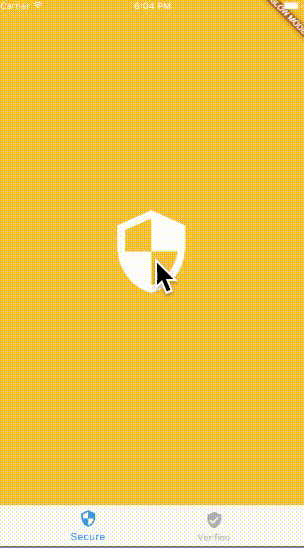如何在Flutter中获取当前路由路径?
102
- Kyaw Tun
1
1Navigator 2.0 中添加了许多新功能:https://medium.com/flutter/learning-flutters-new-navigation-and-routing-system-7c9068155ade
对于新应用程序,请考虑全新的设计。 - Alexey Inkin
14个回答
167
ModalRoute应该给你准确的路由名称
ModalRoute.of(context).settings.name
注意:如果你使用 Navigator.popUntil..,请查看 Rémi Rousselet 的另一个答案 https://dev59.com/7VUL5IYBdhLWcg3wHU_M#50817399。
- ikben
4
你的示例中为什么要导入path包?这与解决方案有关吗? - Nicolai Henriksen
38它不会返回导航器上当前的路线。 - Roger Gusmao
1使用Navigator.popUntil后,这个不起作用了。 - Ashootosh Bhardwaj
这个不起作用是因为我正在使用onGenerateRoute https://dev59.com/cVIH5IYBdhLWcg3wYtOr#60103947。可以通过传递设置来解决此问题:https://github.com/flutter/flutter/issues/50192#issuecomment-590307455 - Alexis
35
如果您想通过使用导航键获取当前路由,则可以使用popUntil方法:
String? currentPath;
navigatorKey.currentState?.popUntil((route) {
currentPath = route.settings.name;
return true;
});
- StasVo
5
1使用嵌套的导航键时,完美的答案,干得好!!! - Eng
6我之前无法理解为什么我所有返回的名称都是 null。后来我发现,在使用 onGenerateRoute 方法手动构建路由时,需要传递“settings”属性并返回以下内容:MaterialPageRoute(
builder: (context) => YourWidget(),
settings: RouteSettings(name: "payment")
) - Dan
1这是一个很棒的技巧,给你一个赞 (+1)。 - Hemant_Negi
1那是一个简单但巧妙的技巧! - Emilio Dalla Torre
3@OliverDixon 这不会弹出路由,因为函数返回 true。 - StasVo
30
NavigatorState没有提供API来获取当前路由的路径,Route也没有提供确定路由路径的API。路由可以是匿名的(通常如此)。您可以使用isCurrent方法确定给定的Route是否在导航器堆栈的顶部,但这对于您的用例不是很方便。我建议您采用不同的方法来解决这个问题,根本不需要回到根路径。相反,为BottomNavigationBar的每个窗格使用不同的Navigator小部件。这样,当在窗格之间切换时,您就不必倒回堆栈。您可以将Navigator小部件包装在Opacity和IgnorePointer小部件中,在不破坏它们的堆栈的情况下隐藏它们。
import 'package:flutter/material.dart';
void main() {
runApp(new MyApp());
}
class MyApp extends StatelessWidget {
@override
Widget build(BuildContext context) {
return new MaterialApp(
home: new MyHomePage(),
);
}
}
class SecurePage extends StatelessWidget {
final int index;
SecurePage(this.index);
Widget build(BuildContext context) {
return new Material(
color: Colors.amber,
child: new InkWell(
child: new Center(
child: new Icon(
Icons.security,
color: Colors.white,
size: index * 100.0 + 20.0,
),
),
onTap: () {
Navigator.of(context).push(
new MaterialPageRoute(
builder: (BuildContext context) {
return new SecurePage(index + 1);
},
),
);
},
),
);
}
}
class VerifiedPage extends StatelessWidget {
final int index;
VerifiedPage(this.index);
Widget build(BuildContext context) {
return new Material(
color: Colors.green,
child: new InkWell(
child: new Center(
child: new Icon(
Icons.verified_user,
color: Colors.white,
size: index * 100.0 + 20.0,
),
),
onTap: () {
Navigator.of(context).push(
new MaterialPageRoute(
builder: (BuildContext context) {
return new VerifiedPage(index + 1);
},
),
);
},
),
);
}
}
class MyHomePage extends StatefulWidget {
@override
State createState() => new MyHomePageState();
}
class MyHomePageState extends State<MyHomePage> {
int _page = 0;
List<Widget> initialWidgets = <Widget>[
new SecurePage(0),
new VerifiedPage(0),
];
Widget build(BuildContext context) {
return new Scaffold(
body: new Stack(
children: new List<Widget>.generate(initialWidgets.length, (int index) {
return new IgnorePointer(
ignoring: index != _page,
child: new Opacity(
opacity: _page == index ? 1.0 : 0.0,
child: new Navigator(
onGenerateRoute: (RouteSettings settings) {
return new MaterialPageRoute(
builder: (_) => initialWidgets[index],
);
},
),
),
);
}),
),
bottomNavigationBar: new BottomNavigationBar(
currentIndex: _page,
onTap: (int index) {
setState(() {
_page = index;
});
},
items: <BottomNavigationBarItem>[
new BottomNavigationBarItem(
icon: new Icon(Icons.security),
title: new Text('Secure'),
),
new BottomNavigationBarItem(
icon: new Icon(Icons.verified_user),
title: new Text('Verified'),
),
],
),
);
}
}
- Collin Jackson
4
22
如果您正在使用go_router包,您可以使用以下代码:
关于 go_router 10.0.0 (2023) 的更新:
GoRouter.of(context).location
关于 go_router 10.0.0 (2023) 的更新:
GoRouterState.of(context).uri.toString();
- ParSa
2
1如果您没有上下文,您也可以使用navigatorKey:
final currentPath = GoRouter.of(navigatorKey.currentContext!).location; - Till Friebeuri.toString()和routeInformationProvider.value.location有什么区别? - Kyle Venn14
我发布这个答案主要是为了存档,但正如@ikben提到的,获取当前路由及其所有属性的一种方法是ModalRoute.of(context)。它返回一个ModalRoute,尽管名称中带有 "Modal",但适用于大多数Navigator.push调用,而不仅仅是showDialog。有用的属性包括Route.settings、Route.navigator和Route.isFirst。
- Levi Lesches
6
如果您正在使用的是go_router包的版本大于等于9.0.0:
GoRouter.of(context).routeInformationProvider.value.location
或者
GoRouterState.of(context).location
- Domenico
3
我在我的项目中使用go_router。在go_router中,您可以如下访问当前路由:
var currentRoute = GoRouter.of(context).location;
- O Vuruşkaner
3
我也遇到了这个问题,当时我正在使用onGenerateRoute。后来我通过使用NavigatorObserver解决了这个问题。
import 'package:flutter/material.dart';
class AppNavObserver extends NavigatorObserver {
static final navStack = <RouteStackItem>[];
@override
void didPop(Route route, Route? previousRoute) {
if (previousRoute != null) {
navStack.removeLast();
}
super.didPop(route, previousRoute);
}
@override
void didPush(Route route, Route? previousRoute) {
navStack.add(RouteStackItem.fromRoute(route));
super.didPush(route, previousRoute);
}
@override
void didRemove(Route route, Route? previousRoute) {
if (previousRoute != null) {
navStack.removeLast();
}
super.didRemove(route, previousRoute);
}
@override
void didReplace({Route? newRoute, Route? oldRoute}) {
if (oldRoute != null) {
navStack.removeLast();
}
if (newRoute != null) {
navStack.add(RouteStackItem.fromRoute(newRoute));
}
super.didReplace(newRoute: newRoute, oldRoute: oldRoute);
}
@override
void didStartUserGesture(Route route, Route? previousRoute) {
// TODO: implement didStartUserGesture
super.didStartUserGesture(route, previousRoute);
}
@override
void didStopUserGesture() {
// TODO: implement didStopUserGesture
super.didStopUserGesture();
}
}
class RouteStackItem {
final String? name;
final Object? args;
const RouteStackItem({
required this.name,
required this.args,
});
factory RouteStackItem.fromRoute(Route route) =>
RouteStackItem(name: route.settings.name, args: route.settings.arguments);
}
在 main.dart 中
MaterialApp(
debugShowCheckedModeBanner: false,
title: flavorConfig.appTitle,
color: AppColors.primary,
theme: AppTheme.light,
navigatorObservers: [
AppNavObserver()
],.....
然后你可以使用这个来从任何地方获取当前路由。
var navStack = AppNavObserver.navStack;
var routeSettings = navStack.isEmpty ? null : navStack.last;
- Funyinoluwa Kashimawo
1
1太棒了! - undefined
2
如果您正在使用
使用这个。
go_router:GoRoute(
name: 'login',
path: '/login',
builder: (context, state) => LoginScreen(),
),
使用这个。
GoRouterState.of(context).path
使用命名路由:
GoRouterState.of(context).name
- NeverEndingQueue
1
我发现了一个更简单的解决方案。我喜欢StatelessWidgets,所以我用了一个static,但你也可以用StatefulWidget。如果你有分层导航,你需要一个StatefulWidget。这是我的NavDrawer中的一个tile。(静态方法在UI中并不差,只有一个进程在运行单个线程。)
class NavListTile extends StatelessWidget {
static String currentRoute = 'dashboard';
final String route;
const NavListTile({
Key? key,
required this.route,
}) : super(key: key);
@override
Widget build(BuildContext context) {
var isCurrent = currentRoute == route;
String suffix = isCurrent ? '_green' : '';
return ListTile(
title: NavMenuItem(capitalizedRoute, isCurrent,
"assets/images/" + route + suffix + ".png", context),
onTap: () {
currentRoute = route;
Navigator.of(context).pushNamed('/' + route);
},
);
}
}
- Michael Bushe
网页内容由stack overflow 提供, 点击上面的可以查看英文原文,
原文链接
原文链接
